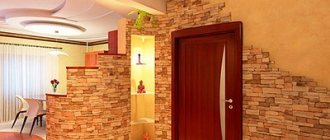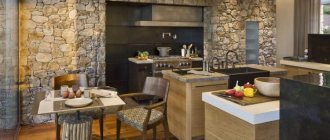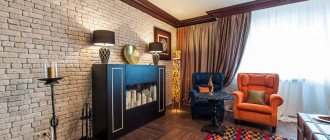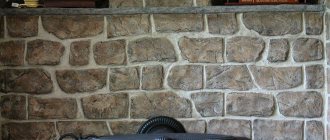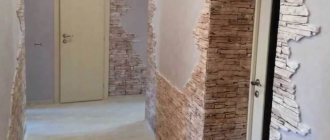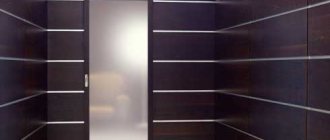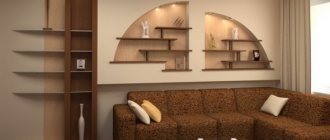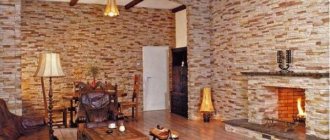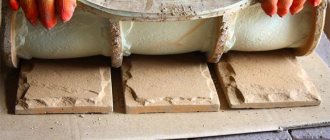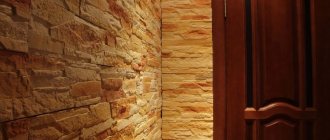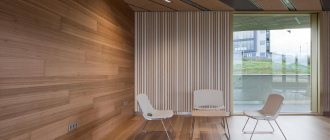SHARE ON SOCIAL NETWORKS
FacebookTwitterOkGoogle+PinterestVk
There are many materials that can be used to decorate and update the interior. Brick-like gypsum tiles are one of the best options, as they have excellent thermal insulation properties, resistance to temperature and humidity changes, and most importantly, are completely environmentally friendly. The article will discuss how best to lay this material and what you should pay special attention to during installation.
Gypsum tiles are an excellent alternative to expensive ceramics
Features of the material
Laying gypsum tiles under brick is a great way to replace real stone. Such material will retain heat better and at the same time it will be easy to install with your own hands. That is why decorative stone is used in many interiors.
It has the following distinctive features:
- The material is durable and resistant to all external factors. Gypsum bricks for interior decoration do not suffer from exposure to moisture and mechanical shock, which also indicates the durability of the material;
- Lighter than regular brick. The decorative stone contains plastic elements that make it lighter than the original brick. This contributes to a wide range of uses of the material and ease of installation;
- Cheaper in price. The price of gypsum stone is always much less than that of ordinary brick. This allows you to save on repairs and maintain your budget.
It is these features that cause the frequent choice of gypsum stone as a material for finishing a room. It is easy to install and affordable, which is not the case with all materials.
Gypsum stone in the hallway Source 2proraba.com
Production of decorative stone from gypsum
The production of gypsum cladding takes place in production conditions
The production of gypsum cladding takes place under production conditions. Mechanization of the process makes it possible to obtain large volumes of products. However, making gypsum bricks at home is not difficult. The main thing is to have molds of the required sizes for its production. Note that templates for the production of gypsum tiles use silicone or plastic.
Decorative brick for interior decoration
In fact, the process of making gypsum bricks looks like this:
- First, plaster of Paris is mixed with water. The mass should have the consistency of liquid sour cream. In this case, a mixer is used, which prevents the appearance of lumps in the gypsum mass and removes air bubbles.
- The finished mixture is poured into prepared and greased molds in one step.
- The poured bricks dry for 1-2 days, after which the tiles are removed from the molds and packaged.
Important: gypsum cladding is a fragile material and therefore requires careful handling. Impacts and falls can lead to chips or complete destruction of the bricks.
Composition of gypsum stone
This material contains gypsum for decorative stone. It is the main element in the composition. But besides this, other components are added to the working solution:
- marble chips;
- sand;
- different dyes;
- slaked lime;
- other additives that depend on the type of material.
Decorative products differ from each other in composition, therefore their level of strength and wear resistance is also different. Water purified from destructive impurities is also added to the solution. The resulting mixture is poured into molds and remains in them until completely hardened.
Types of gypsum bricks for interior decoration
Decorative gypsum bricks are divided into several types. A wide selection of types of such finishing materials allows you to choose a stone for any interior. Before making a final choice between the presented options, you need to familiarize yourself with the features of each building material.
crushed brick
Such gypsum bricks resemble an uneven and rough surface. Can be compared to natural stone mined in the mountains. The coating, made in the form of chips, is used mainly in corridors, offices and public buildings. The technology for producing such a stone is quite complex, since it is necessary to make the surface uneven before the solution has time to dry.
Custom tile Source roomester.ru
Sawn gypsum tiles
The surface of this material is also uneven, but it does not look rough. You can see specially made chips and cracks on it, which add coziness to the interior. They are mainly used in the kitchen as an apron over cabinets. The composition is denser than that of crushed brick, but the edges are smoother.
See also: Catalog of companies that specialize in finishing and small forms
Rubble stone
This type of gypsum stone resembles boulders. The surface is close to the real material. It is smoothed, but with slight roughness. The corners of the stones are rounded, there is a small distance between them. This option most closely resembles natural material, which adds aesthetics to the room.
Free form
This option can combine several types and methods of laying decorative bricks. Here it is allowed to alternate rough and smooth stones, to compare small and large materials with each other. This way the designer will be able to find a unique and interesting design or decoration option for the building both inside and outside. It is used mainly for the design of art objects and is almost never used in residential premises.
Decorative tiles Source 2proraba.com
Figured gypsum tiles
The only type from the category of these building materials that does not try to create an imitation of stone or brick. Figured tiles are a relief and patterned ornament that can be made in all sorts of shapes. Also, 3D panels are now being actively introduced, characterized by visible volume and an interesting design solution.
Advantages and disadvantages
Gypsum bricks for interior decoration are a very good choice as a building material. It is unpretentious in installation and further use. Also among the advantages are the following aspects:
- contains environmentally friendly components that do not adversely affect the human body;
- a wide selection of types of finishing materials allows you to choose a stone for any room;
- gypsum brick has good sound insulation properties and does not allow heat to pass through;
- the material is treated with a special fire-retardant compound, so in case of an emergency it will not ignite;
- ease of installation and installation, you can do it yourself without the help of specialists;
- low price compared to other wall finishing materials;
- You can lay it on any surface, and gypsum tiles will last for many years and will not chip.
Types of gypsum bricks
The cladding is a decorative tile made from gypsum mass
The cladding is a decorative tile made from gypsum mass. The parameters of gypsum finishing bricks fully correspond to standard bricks. That is, the length of the blocks varies within 18-24 cm, height - within 7-15 cm, but the thickness of the tiles allows you to lay the finish on the wall according to the principle of standard ceramic cladding, and is equal to 2-2.5 cm. Sometimes the manufacturer allows himself offer the buyer a gypsum panel in the form of a decorative brick. Such fragments are easier and faster to mount on the wall. That is, the elements look like pieces of brickwork that need to be assembled on the wall like a puzzle. The dimensions of such cladding can be on average 250x350x25 mm. Sometimes a little more, sometimes a little less, but depending on the type of stone that the cladding imitates.
It is worth noting that the manufacturer offers the buyer a fairly wide range of gypsum finishes in the form of bricks. So, the buyer can choose this type of cladding to his taste:
- Stones with a matte surface;
- Glossy tiles;
- Bricks with aging effect;
- Facing blocks of concave shape;
- Bricks are convex, embossed, etc.
Tools for laying gypsum-based tiles
Laying gypsum tiles under brick is carried out according to established rules. In order for the installation to be carried out correctly, it is necessary to follow all the stages and not miss anything. First, you should prepare the tools that you will need during the work process. If some elements are missing, you can easily purchase them in a special hardware store.
To install gypsum tiles you will need the following tools:
- hacksaw;
- building level;
- glue brushes;
- file;
- pencil;
- roller;
- primer;
- tile adhesive.
Additional materials may be required as installation progresses; this is just the basic set required.
Installation features
The quality of laying the future gypsum surface depends on each stage. Therefore, it is worth approaching installation work with all responsibility. Laying gypsum tiles requires careful preparation and well-formulated materials. Only in this case will the material be used for a long time. Let's look at each step separately.
Laying tiles with your own hands Source sense-life.com
Video description
This video shows the installation of decorative gypsum stone:
Step 3. Laying tiles
It is important to properly prepare the adhesive composition first. It should be mixed until a thick mass is formed. The glue is applied loosely to the place where the tiles will be laid. The material itself is pressed tightly against the wall and held for a few seconds. It is better to remove residues and excess glue immediately using a special sponge.
Laying gypsum tiles under brick begins from the bottom corner, gradually moving to the central part. It is better to immediately lay out the stones in even rows without gaps or gaps, so as not to cover them with grout later. After installation, you can paint the joints with paint to match the color of the material to restore the original appearance, matching the base material.
Step 4. Checking the general condition
After the installation of all the tiles has been completely completed, it is worth assessing the general condition of the gypsum material. It is important to monitor each joint so that the distance between the tiles is not too large. If necessary, go through the grout again. If everything was done correctly, the gypsum stone will last a long time.
Laying gypsum tiles Source krrot.net
Pros and cons of the material
Decorative brick made from gypsum has both advantages and disadvantages. The advantages include:
- environmental friendliness;
- aesthetics;
- simplicity of processing;
- fire resistance;
- ease of installation;
- light weight;
- thermal insulation.
In addition, the craftsmen emphasize that this decorative finishing material not only has a beautiful appearance, but also a low price. This elegant product perfectly imitates brickwork. Besides, it’s easy to work with, the main thing is to get used to it.
But no matter how much odes are sung to gypsum brick, it still has a drawback, the most important one being its low resistance to mechanical damage. This means that the finish can be damaged without much difficulty. However, if you adapt, it will be quite possible to restore the damaged area.
The modern market offers a wide variety of products that differ in external properties. Some types can be distinguished:
- glossy;
- matte;
- raised;
- convex;
- concave.
Briefly about the main thing
Gypsum for decorative stone is used in almost every modern design. This material is a budget and modernized version of conventional brick. It is lighter, easier to install and suitable for all types of surfaces. That is why when choosing an artificial surface, attention is paid to gypsum stone.
A large assortment allows you to choose the material for each room. But the types are very different from each other, so it is worth studying in detail the properties of each and comparing them with the technical characteristics of the room. You can do the installation yourself, but it is important to follow all the rules and strictly follow the instructions. Only then will gypsum tiles become an excellent addition to the interior of the house.
Ratings 0
Additional finishing of gypsum brick
Gypsum bricks used in the interior can be additionally decorated in the desired color, if this was not done at the production stage
Gypsum bricks used in the interior can be additionally decorated in the desired color, if this was not done at the production stage. Most often, the consumer prefers to use decorative cladding with ready-made shades that imitate old stone or rock bricks. But what if the tiles were purchased in semi-finished format, that is, white? In this case, you can decide on the decoration issue yourself. The following mixtures are used as coloring matter:
Facade cladding with clinker tiles
- Water-based paint of the desired shade. Moreover, you can simply roll the entire surface of the finish with a roller, or you can leave gaps and highlights on the surface of the stone. This activity is quite tedious, but the creative process gives rise to individuality.
- Coloring impregnation for concrete products. This mixture does not require additional protection from above and goes on smoothly and quickly.
- Water-soluble varnish is used as a protective coating for gypsum bricks. Such a thin film will not only protect the shade of the tile from abrasion, but will also provide the ability to wet clean the brick panel or cladding.
- Glaze. Also used to create a protective layer on the surface of brick tiles.
